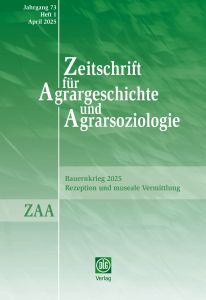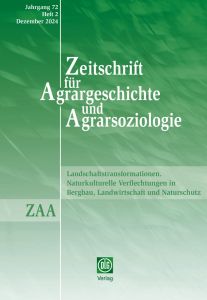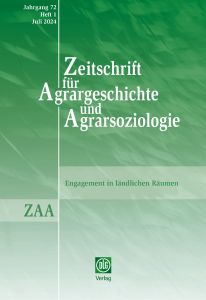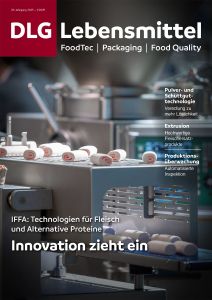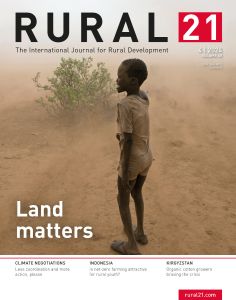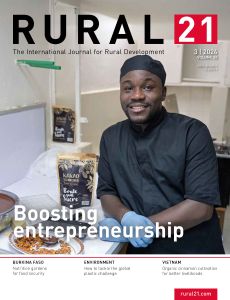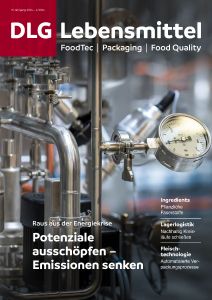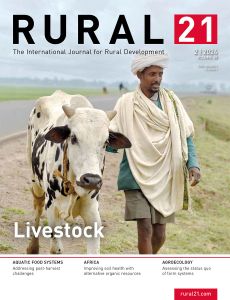Verstecke Angebote
-
DLG Lebensmittel 2/2025
Im Mittelpunkt des Heftes stehen Fachartikel und Praxisbeiträge zu den Themen "Lebensmittelqualität", "Sensorik", "Lebensmitteltechnologie", "Ingredienzien" sowie "Kommunikation/Marketing". Ein aktueller Blick in die Entwicklung der Lebensmittelmärkte rundet das Angebot ab. Damit werfen wir einen ganzheitlichen Blick auf die „Welt der Lebensmittel“ – von der Entwicklung, über die Produktion bis zur Vermarktung.
Erfahren Sie mehr -
Zeitschrift für Agrargeschichte und Agrarsoziologie 1/2025
Schwerpunkt dieser Ausgabe: "Bauernkrieg 2025. Rezeption und museale Vermittlung", erscheint 2x jährlich (April und Oktober)
Erfahren Sie mehr -
Zeitschrift für Agrargeschichte und Agrarsoziologie 2/2024
Schwerpunkt dieser Ausgabe: "Landschaftstransformationen. Naturkulturelle Verflechtungen in
Erfahren Sie mehr
Bergbau, Landwirtschaft und Naturschutz", erscheint 2x jährlich (April und Oktober) -
Zeitschrift für Agrargeschichte und Agrarsoziologie 1/2024
Schwerpunkt dieser Ausgabe: "Engagement in ländlichen Räumen", erscheint 2x jährlich (April und Oktober)
Erfahren Sie mehr -
DLG Lebensmittel 1/2025
Im Mittelpunkt des Heftes stehen Fachartikel und Praxisbeiträge zu den Themen "Lebensmittelqualität", "Sensorik", "Lebensmitteltechnologie", "Ingredienzien" sowie "Kommunikation/Marketing". Ein aktueller Blick in die Entwicklung der Lebensmittelmärkte rundet das Angebot ab. Damit werfen wir einen ganzheitlichen Blick auf die „Welt der Lebensmittel“ – von der Entwicklung, über die Produktion bis zur Vermarktung.
Erfahren Sie mehr -
Rural 21 (engl. Ausgabe 4/2024)
Focus 4/2024: Land matters
Mid-December 2024, the 16thConference of the Parties to the United Nations Convention to Combat Desertification – UNCCD COP 16 for short – was forming the conclusion of a “triple COP Year” in which three important UN Conventions (UNCCD, UNFCCC and CBD) were negotiated in just three months’ time. What the three COPs have in common is that they need land to implement their targets – land that is scarce and confronted with increasingly competing demands.
Our authors and interview partners show what the impacts of insufficiently considering this interconnectedness in the Rio Conventions are like, and what has to be done to achieve more coherence in putting them into practice on the ground. Here, not only do they clarify the economic benefits of mutual action – for of course the implementation of the Conventions is above all a matter of (scarce) financial resources.
Above all, they refer to practical examples from very different regions throughout the world of how people and the environment can benefit from integrated approaches, so that balancing economic, environmental and social needs can really be achieved. And here, they once again show how important a rights-based approach is which also addresses the needs, experience and expertise of Indigenous Peoples, women and local communities.
Erfahren Sie mehr -
Rural 21 (engl. Ausgabe 3/2024)
Focus 3/2024: Boosting entrepreneurship
Over the last few years, rural entrepreneurship has claimed its stake in the international cooperation agenda – and there are clear reasons for this. Entrepreneurship creates jobs and generates income and wealth; it makes staying in rural areas an attractive proposition for young people and helps them build confidence and status. Rural entrepreneurs can contribute to coping with today’s environmental challenges. They are able to promote the circular economy and assist in safeguarding the environment, thereby adding value to the abundant natural resources of rural areas. This is above all important for those living together with and from nature, such as indigenous communities. And last, but not least, entrepreneurship is regarded as a vital tool for women’s empowerment.
The factors determining whether young enterprises are successful and can hold their own on the market can generally be divided into two categories: the entrepreneurial mindset and various skills of the (future) entrepreneurs themselves, and the framework conditions in which they are acting, such as the legal environment, infrastructure, training possibilities and, above all, access to finance. Social values and norms play a crucial role too, especially when it comes to women entrepreneurs making progress. Referring to their projects, our authors and interview partners show what helps young enterprises in rural areas to become successful, what helped them achieve their own aspirations, and where they see shortcomings.
Erfahren Sie mehr -
DLG Lebensmittel 4/2024
Im Mittelpunkt des Heftes stehen Fachartikel und Praxisbeiträge zu den Themen "Lebensmittelqualität", "Sensorik", "Lebensmitteltechnologie", "Ingredienzien" sowie "Kommunikation/Marketing". Ein aktueller Blick in die Entwicklung der Lebensmittelmärkte rundet das Angebot ab. Damit werfen wir einen ganzheitlichen Blick auf die „Welt der Lebensmittel“ – von der Entwicklung, über die Produktion bis zur Vermarktung.
Erfahren Sie mehr -
DLG Lebensmittel 3/2024
Im Mittelpunkt des Heftes stehen Fachartikel und Praxisbeiträge zu den Themen "Lebensmittelqualität", "Sensorik", "Lebensmitteltechnologie", "Ingredienzien" sowie "Kommunikation/Marketing". Ein aktueller Blick in die Entwicklung der Lebensmittelmärkte rundet das Angebot ab. Damit werfen wir einen ganzheitlichen Blick auf die „Welt der Lebensmittel“ – von der Entwicklung, über die Produktion bis zur Vermarktung.
Erfahren Sie mehr -
Rural 21 (engl. Ausgabe 2/2024)
Focus 2/2024: Livestock
Regarding the transformation of our agricultural and food systems, hardly any sector has been as controversially discussed as livestock farming. In the Global North, quite a few people would like to see animal products entirely deleted from the human diet – because this could reduce the emission of harmful greenhouse gases; because valuable natural resources such as land and water could be used more efficiently; because deforestation to create pastureland could be stemmed, which would protect biodiversity; and because, in many cases, they cannot reconcile animal husbandry with their animal welfare aspirations. Not to mention the rapid growth of malnutrition and nutrition-related illnesses through excessive consumption of animal-sourced food and health risks such as the transmittance of zoonotic diseases.
However, a world without animal agriculture is simply not realistic. The issue here is not just that of producing food such as milk, eggs and meat, which represent an important source of proteins and micronutrients for many people, or of using draught animals for land cultivation. For women in particular, keeping small livestock is often the only option to earn their own income, and is hence key to economic and social empowerment. Animals can serve as forms of saving, insurance and social security. And they are an integral element of the urgently needed agro-ecological transformation, which is also based on the principles of the circular economy and (nutrient) recycling.
By declaring 2024 the International Year of Camelids, the United Nations has been highlighting the importance of these animals – and hence also the importance of the pastoralist way of living – for food security and ecosystem functions. Knowing fully well that sustainable solutions for tomorrow’s livestock systems always need a multi-faceted and context-specific lens, our authors ultimately back livestock farming too.
Erfahren Sie mehr


